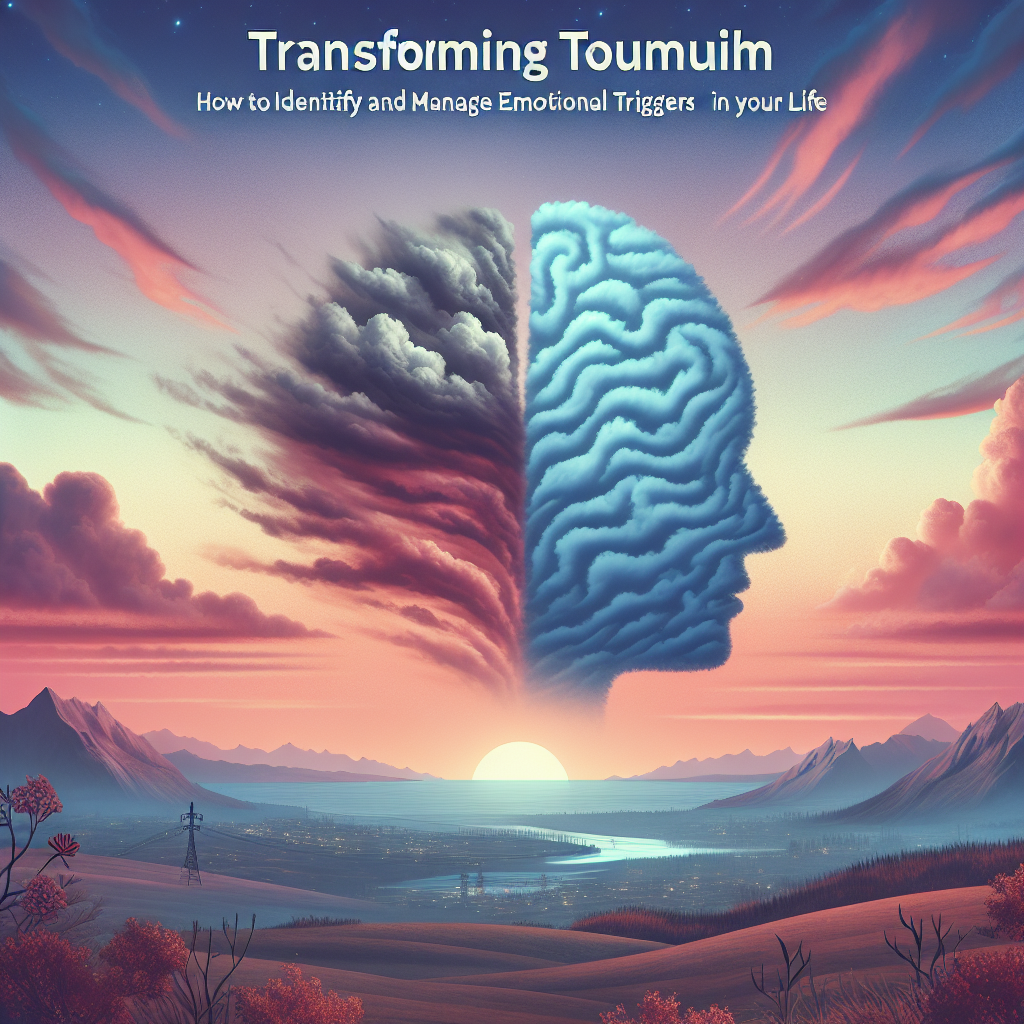Transforming Turmoil: How to Identify and Manage Emotional Triggers in Your Life
Introduction
In today’s fast-paced world, emotional upheaval is more common than ever. Stress from daily obligations, strained relationships, and the constant pressure to succeed can lead to turmoil. You might find yourself feeling overwhelmed by emotions that seem to take control, and the cycle can feel unending. But what if you could learn to identify and manage these emotional triggers? The journey of transforming turmoil into emotional clarity isn’t just necessary; it is essential for your well-being and overall happiness. This guide will empower you with the insights and tools to take charge of your emotional landscape and foster resilience amidst life’s chaos.
Understanding Emotional Triggers
What Are Emotional Triggers?
Emotional triggers are stimuli—situations, thoughts, or memories—that provoke strong emotional reactions. This can include feelings of anger, fear, sadness, or anxiety. Understanding these triggers is crucial because they can stem from past experiences and deeply rooted beliefs.
The Importance of Recognizing Triggers
Recognizing your emotional triggers is the first step in transforming your turmoil. By understanding what sets off your feelings, you can create a strategy for managing them effectively. This self-awareness helps transition from a reactive state to a more responsive and adaptive approach to challenges.
Case Study: Alex’s Discovery
Take the case of Alex, an entrepreneur who found himself enraged during team meetings. After digging deeper, he discovered that criticism reminded him of harsh feedback received during childhood. By acknowledging this trigger, Alex developed strategies to communicate more constructively instead of reacting defensively.
Types of Emotional Triggers
1. Situational Triggers
These occur in specific environments, like workplaces or social settings. For instance, conflict at work might trigger feelings of inadequacy or anxiety based on past experiences.
2. Relational Triggers
Interpersonal relationships can activate emotional memories, reminding us of past disappointments or betrayals. Learning about these triggers can mend or break relationships.
3. Environmental Triggers
The physical space around you can also impact your emotions. For instance, cluttered or chaotic surroundings can create feelings of anxiety or frustration.
Identifying Your Emotional Triggers
To embark on the journey of transforming turmoil, you first need to identify your emotional triggers. Here are some practical ways to begin:
Journaling
Keeping a daily journal can help you reflect on your emotions and identify patterns that arise in response to different situations.
Mindfulness Practices
Engaging in mindfulness exercises helps you become aware of your thoughts and feelings in the present moment, making it easier to spot emotional triggers as they occur.
Emotional Check-Ins
Pause during the day to evaluate how you feel. What triggered your emotions? This self-awareness reinforces your ability to manage responses effectively.
Strategies for Managing Emotional Triggers
1. Develop Healthy Coping Mechanisms
Instead of reacting impulsively, establish coping strategies that help stabilize your emotions. This can include deep breathing, talking to a friend, or engaging in physical activity.
2. Cognitive Behavioral Techniques
Utilize cognitive behavioral strategies to challenge negative thought patterns. Ask yourself if your response matches the situation or if it stems from past experiences.
3. Set Boundaries
Often, emotional triggers arise from overcommitting or not establishing personal limits. Setting clear boundaries can protect your emotional space.
4. Emotional Regulation Techniques
Practice techniques such as guided imagery or visualization to calm your mind during stressful moments. These tools foster a sense of control over your emotional responses.
5. Seek Professional Help
Sometimes, working with a therapist or counselor can provide valuable insights and coping strategies tailored to your unique experiences and triggers.
Case Study: Sarah’s Transformation
Sarah, who struggled with anxiety during social events, utilized journaling and mindfulness to identify her fear of judgement. By seeking therapy, she learned to replace negative thoughts with affirmations, allowing her to enjoy social gatherings without overwhelming stress.
Practical Tools for Identifying and Managing Triggers
| Tools | Purpose | Implementation |
|---|---|---|
| Journaling | To reflect on emotions and patterns | Daily entries focusing on thoughts and triggers |
| Mindfulness | To enhance present moment awareness | Short daily meditation sessions or apps |
| Cognitive Behavioral Strategies | To reframe negative thinking | Structured worksheets or therapy sessions |
| Deep Breathing Exercises | To stabilize emotions during high stress | Regular practice, especially in tense situations |
Conclusion
Transforming turmoil is not just about understanding your emotional triggers; it’s about taking actionable steps to manage your emotional landscape effectively. By identifying triggers, developing coping mechanisms, and establishing healthy boundaries, you can reshape your emotional experiences into something manageable and empowering. Let this journey be the path toward clarity, control, and confidence.
Call to Action
As you wrap up this insight into transforming turmoil, consider setting a small, achievable goal related to managing your emotional triggers today. Whether it’s starting a journal or practicing mindfulness, every step you take toward self-awareness will illuminate your path toward emotional well-being.
FAQs
1. What are some common emotional triggers?
Common triggers include criticism, rejection, feeling unheard, stressful environments, and past trauma.
2. How can I quickly identify my triggers?
Keep a journal of your emotional responses to events. Paying attention to recurring situations will help you pinpoint triggers.
3. Are emotional triggers the same for everyone?
No, emotional triggers are unique to each individual and often stem from personal experiences and histories.
4. What if I can’t identify my triggers?
Consider seeking help from a mental health professional who can assist you in exploring your emotional landscape more deeply.
5. Is it possible to completely eliminate triggers?
While you may not be able to eliminate all triggers, you can learn to manage your reactions to them effectively, reducing their impact on your life.
The journey of transforming turmoil: how to identify and manage emotional triggers in your life requires consistent effort but can lead to profound personal growth and emotional resilience. Start today!

